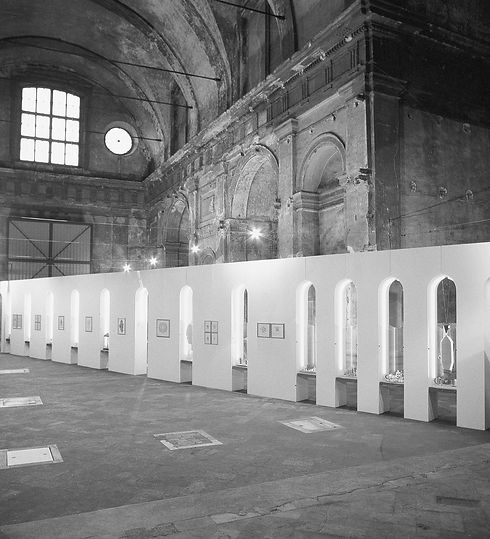history
Italian design factory founded in 1921
Explore the history and origins of Alessi and discover how its partnerships with the most interesting designers were formed.


1920 -
starting point
In 1921, Giovanni Alessi and his brother founded the "workshop for casting brass and nickel silver plates - Fratelli Alessi Omegna - FAO. The first products of FAO were inspired by the 20 The most prestigious manufacturer of products at the beginning of the century. Giovanni was fascinated by high quality and exquisite workmanship: nickel, chrome or silver plating on the surface of products made of raw copper, brass and nickel silver, these products are It is famous for its meticulous workmanship and perfect appearance.
1930-
Carlo Alessi
In 1932, Giovanni's eldest son, Carlo Alessi, joined the family business and designed most of the products manufactured by the business between the mid-1930s and 1945. The company accelerated its development in the 1930s, the number of employees in the manufacturing department increased, and an initial sales layout was established. The first original, independently creative products began to be produced under Carlo's efforts. By the end of the century, due to political reasons, the rapid development of enterprises slowed down.


1940 -
war
Due to the outbreak of the Second World War, Fratelli Alessi Omegna needed to use the original production line for the arms industry. After the war, FAO returned to normalcy, which laid the groundwork for the next transformation, as the company moved from an artisanal to an industrial scale of production. In addition, it sharpened the product image, competing with the leading companies in the field and gradually infiltrating the emerging Italian design scene.
1950 -
Ettore Alessi
The company gradually abandoned the use of soft metals and began to use stainless steel in the 1950s, transforming production from handicrafts to industrial production. The name was changed to: ALFRA (ALessi FRAtelli). During these years, the company specialized in producing products for specific venues (for example, for hotels, restaurants, bars, etc.). Carlo Alessi, the eldest son of the founder, takes over the company from his father. His brother Ettore joined in 1945 as head of the engineering department and began making baskets and fruit bowls out of steel wire. Under his leadership, ALFRA also began to cooperate with independent designers.


1960 -
Ceselleria Alessi
In the 1960s, a range of products for home use was designed. The "Ceselleria Alessi" collection reinterpreted the style of traditional silverware, which was very much in line with the trend of the time and quickly became a bestseller. The high-quality workmanship of the new polished and satin-finished steel products also made the Italian company a success at a time when the international market was exploding. In 1964, the award was awarded the prestigious "Industrial Mercurio d'Oro Award", beating out more than 100 competing companies and becoming one of the most creative and enterprising companies in the sector, winning the prestigious reputation.
1970 -
first batch of design heroes
In 1970 Alberto Alessi - grandson of the founder - joined. His first designs were a set of trays and baskets, a modular table service system by Franco Sargiani and Ejia Helander and Alessi d'Après.
Alessi d'Après is a research institute for the production of "works of art", which involved Salvador Dalì: Alberto hoped that the production would not only be functional, but also respond to people's needs for art.
In the 1970s, transforming the company into a design factory imagined by Alberto.


1980 -
Tea and Coffee Plaza
In the first half of the 1980s, in collaboration with Alessandro Mendini, the "Tea and Coffee Square" activity was launched, aiming to explore talents applying the language of architectural design in the international architectural community. Published in 1983, the "Tea and Coffee Square" study was a huge success both with the public and with critics, placing Alessi firmly among the Italian design factories. The event also brought fame to two new designers, Aldo Rossi and Michael Graves.
1990 -
Young designers and new materials
Centro Studi Alessi (CSA) opened in the early 90s with a mission: to provide a theoretical contribution to things related to objects, with a desire to work with young designers.
Alessi's research opened the door to new design languages, creating iconic products of the time, such as Guido Venturini's Firebird lighter or Stefano Giovannoni's Mary Biscuit container. At the time, other materials were used almost exclusively in production alongside steel. Inside there are items made of wood, plastic, glass, porcelain, ceramics, and more.


2000 -
Tea House and Coffee Tower
The design and operation of the tea and coffee tower started in the 20s, following the tea and coffee assumption. The theme that the architects came up with at the time was the "tea set", transforming mass production into a smaller scale.
A number of new collaborations have been established in the department, including those with David Chipperfield, Doriana and Massimiliano Fuksas, Zaha Hadid and Toyo Ito, perfecting Alessi's eclectic philosophy. Alessandro Mendini pointed out: "All previous theories have been further interpreted and developed."
2010 -
Moral and Radical
"Moral", is seen as leaning towards simplicity and austere design. "Radical" indicates that strongly expressive and decorative forms are being sought. Despite the variety of languages, design with a "radical" stamp and design with a moral bent can still be appreciated along the dichotomy (e.g. Naoto Fukasawa or David Chipperfield. Actually , an exploration between the 'ethical' and the 'radical', is an attempt to define a more complex reality in design as an artistic and poetic discipline of creation.

2020 -